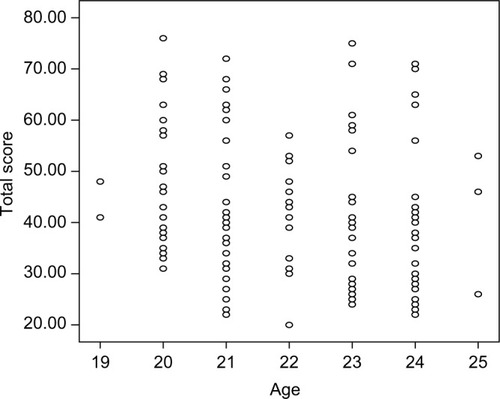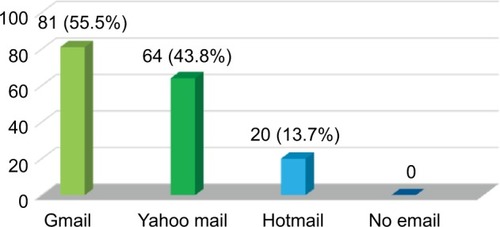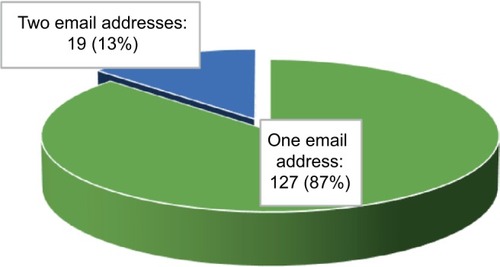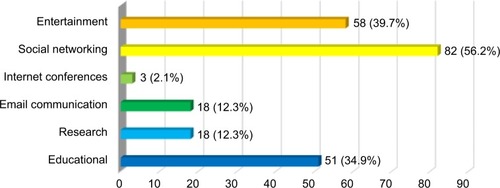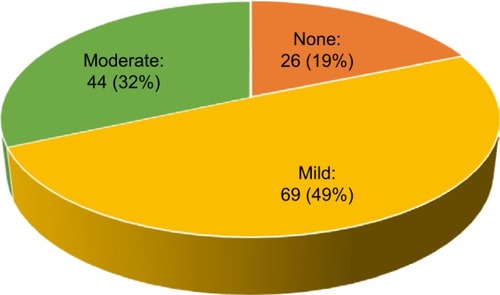Abstract
Background
The use of Internet has now become indispensable, and the technology has revolutionized the medical education and practice worldwide. Currently, medical students and professionals have an enormous opportunity to keep them always updated with the exponential growth of knowledge because of potential progression of Internet throughout the world that enables them to become a lifelong learner. Internet addiction is a widespread phenomenon among students and academicians at universities in Malaysia. Students use the Internet for recreational purpose and personal and professional development. The Internet has become an integral part of day-to-day life of the university students, including medical students. The aim of the present study was to examine the Internet use and addiction among students of Universiti Sultan Zainal Abidin, Malaysia.
Methods
This was a cross-sectional study in which a questionnaire, Internet Addiction Diagnostic Questionnaire, developed by the Center for Internet Addiction, USA, was used. One hundred forty-nine medical students of Universiti Sultan Zainal Abidin participated in this study. Data were analyzed using Statistical Package for the Social Sciences software.
Results
The mean scores were 44.9±14.05 and 41.4±13.05 for male and female participants, respectively, which indicated that both the genders were suffering from mild Internet addiction.
Conclusion
This study shows almost similar level of Internet usage among medical students irrespective of their socioeconomic background, with no statistically significant (p>0.05) differences, except among the years of study (p=0.007). Overall, from the research data and having worked with this cohort very closely, Universiti Sultan Zainal Abidin medical students can be labeled as wonted and recurring users of the Internet. Nevertheless, it is very difficult to define as Internet addicts or pathological users of the Internet because of small sample size and cross-sectional study.
Video abstract
Point your SmartPhone at the code above. If you have a QR code reader the video abstract will appear. Or use:
Introduction
The use of Internet has now become indispensable, and the technology has revolutionized the medical education and practice worldwide. Medical students have the opportunity to keep updated with the exponential growth knowledge to become a lifelong learner. The use of the Internet has grown enormously, and students and academicians at universities in Malaysia have started using the Internet for acquiring knowledge, searching information, entertainment, mail, and social interaction.Citation1,Citation2 Rapid expansion and proliferation of the Internet has provided better opportunities for communication, information, and social interaction. Moreover, medical schools in both developed and developing countries are utilizing educational technology to bring effective changes in medical education.Citation3
A number of studies reported that Malaysian university students spend a major portion of their time in accessing the Internet for both academic and extracurricular purposes.Citation1,Citation2,Citation4 One study has reported that Internet usage was very high among university students; therefore, researchers consider it as “pathological Internet use (PIU)”.Citation5 PIU is a new kind of mental illness afflicting some individuals surfing online. Many researchers consider the main causes of PIU as extreme use of the Internet or misuse of some Internet functions. Multiple studies report that around 13%–18% of the study population of a public university in Malaysia and UK were suffering from PIU.Citation6,Citation7 Furthermore, a number of studies from different countries and universities have reported excessive use of Internet at the level of addiction leading to lots of adverse reactions such as depression, anxiety, hostility, interpersonal sensitivity, psychoticism, psychosomatic symptoms, lack of physical energy, physiological dysfunction, weakened immunity, emotional symptoms, behavioral symptoms, and social adaptation problems.Citation8–Citation20 Nevertheless, despite the tremendous potential of the Internet, riotous overuse by some individuals throughout the world has led to the development of new ideas that could be denoted equally as addictive behavior with mental health implications.Citation21–Citation27
The term addiction has generally been associated with substance use.Citation28 Again, such excessive Internet use is considered as addiction since symptoms of Internet addiction (IA) are comparable to the symptoms of addiction to nicotine, alcohol, or drugs.Citation24 The term IA is defined as “a psychological dependence on the Internet, regardless of the activity once logged on”.Citation29 Furthermore, IA is described as “characterized by excessive or poorly controlled preoccupations, urges, or behaviors regarding computer use and Internet access that lead to impairment or distress”.Citation30 The Diagnostic and Statistical Manual of Mental Disorders, Fifth Edition (DSM-V) identifies Internet Gaming Disorder in Section III as a condition warranting more clinical research and experience before it might be considered for inclusion in the main book as a formal disorder.Citation31 Thus, IA is documented as a psychiatric ailment with precise diagnostic and management principles. Also, an editorial note in the American Journal of Psychiatry states that “IA appears to be a common disorder that merits inclusion in DSM-V”.Citation25 The US psychiatrist Jerald Block thought that IA was a “compulsive–impulsive spectrum disorder” and that the definition should include “online or offline computer usage, with recognition of at least three subtypes. The subtypes are as follows: excessive gaming, sexual preoccupations, and email/text messaging”.Citation25
The Daily Telegraph reported that compulsive Internet usage is a public health delinquent which became such a serious issue that there was an urgent need to formally document it as a clinical ailment.Citation32 A number of reports published in reputed journals and leading newspaper The Guardian claimed that South Korea is one of the leading countries where IA is a serious public health issue.Citation32–Citation34 However, Dr Ronald Pies, Professor of Psychiatry, SUNY Upstate Medical University, Syracuse, New York, and Clinical Professor of Psychiatry, Tufts University School of Medicine, Boston, Massachusetts, described that it is an urgent necessity to consider obsessive Internet usage as a complete and distinct mental illness, an increasing number of studies recommend that some individuals with IA are at substantial risk and demand specialized care and treatment because of the risk of grave psychological, emotional, and physical complications.Citation27,Citation35–Citation37 Among the most common adverse reactions due to excessive Internet use are isolation from family members and community, refusing to answer calls, musculoskeletal pain, headache, and eye irritation.Citation13 Internet usage, especially online gaming, has been so severe that it has led to the establishment of specialized treatment centers in South-East Asia, the US, and Europe, reflecting the growing need for professional help.Citation37
A number of studies have been conducted in this field among the university students of Malaysia, but there has been little focus on medical students, particularly in the east coast of Malaysia and at Universiti Sultan Zainal Abidin (UniSZA). The aim of the present study was to examine the Internet use and addiction among students of UniSZA, Malaysia.
Materials and methods
This cross-sectional study was conducted among the medical students of UniSZA of Year 1–5 during the academic session 2014–2015. The data were collected in October 2015. A questionnaire, Internet Addiction Diagnostic Questionnaire,Citation38–Citation40 developed by the Center for Internet Addiction, USA (http://netaddiction.com/internet-addiction-test/)Citation40 was used to collect the data. Formal permission was obtained from the Center for Internet Addiction (Dr Kimberly Young) to use this questionnaire for the present study. The Internet Addiction Diagnostic Questionnaire is a widely utilized screening instrument examining compulsive Internet use.Citation41 The questionnaire was slightly modified to add sociodemographic parameters and applied to the context of UniSZA. The simple random sampling technique was used to select the cohort. The sample size was calculated as 169 among a total of 300 medical students of Faculty of Medicine, UniSZA, using a sample size calculator.Citation42 Another 10% was added to counter the missing value of questionnaires due to potential nonresponse, bringing the total number of subjects to 186. Unfortunately, when data were collected during a prearranged time in the lecture hall, only 149 students returned the questionnaire, with 37 students not completing the questionnaire, despite the research participants being evidently explained the purpose and personal confidentiality of the research.
The questionnaire contains 20 questions that examine the symptoms of IA based upon a five-point Likert scale (0=Not applicable, 1=Rarely, 2=Occasionally, 3=Frequently, 4=Often, 5=Always). After all the questions were answered, the numbers for each response were added to obtain a final score. The higher the score, the greater is the level of addiction and creation of problems resulting from such Internet usage. The severity impairment index is determined as follows:
None: 0–30 points
Mild: 31–49 points. You are an average online user. You may surf the Web a bit too long at times, but you have control over your usage.
Moderate: 50–79 points. You are experiencing occasional or frequent problems because of the Internet. You should consider their full impact on your life.
Severe: 80–100 points: Your Internet usage is causing significant problems in your life. You should evaluate the impact of the Internet on your life and address the problems directly caused by your Internet usage.
Sociodemographic data such as age, gender, marital status, year of study, and another five closed-ended Internet-related questions were added to the original questionnaire. A pilot study was conducted on 15 undergraduate students and it was found that the survey instructions and items were easily comprehensible and suitable for the study. The students who participated in the pilot study were excluded from the final study. Most of the sections of this questionnaire demonstrated acceptable values of Cronbach’s alpha, with a range between 0.672 and 0.882, which indicated that both instruments possessed good internal consistency and reliability. Evidence of convergent validity was shown by the significant correlations between the items of each section and the overall mean in each section (rs =0.332–0.718; p<0.05).Citation43,Citation44 The data were then compiled and analyzed using Statistical Package for the Social Sciences Version 21 (IBM Corporation, Armonk, NY, USA). Quite a number of missing values were noted and the cases with missing values were excluded from the analysis automatically by SPSS. However, for the descriptive analysis of the sociodemographic characteristics of the participants and the questions on IA, the missing values were coded as “not known”.
For conducting this research, the certificate of ethical approval was obtained from the UniSZA Research Ethics Committee (UniSZA, C/1/UHREC/628-1 (44), August 3, 2015). The UniSZA Research Ethics Committee had examined the questionnaire before the study was started and was satisfied that there were no sensitive questions. Research ethics were strictly maintained, especially regarding confidentiality. The current research was totally anonymous and voluntary. Adequate explanation concerning the purpose of the study was provided to the participants, and informed consent was obtained to utilize their data for research purposes.
Results
The sociodemographic characteristics of the participants are shown in . A total of 149 participants returned the questionnaire; giving a response rate of 80.11%. The study participants’ (SPs) mean age was 22.0±1.54 years. Among them, 40.3% and 55.7% were male and female, respectively. Most of them (81.9%) were single, and 20.1%, 20.1%, 15.4%, 19.5%, and 20.1% were from Year 1, 2, 3, 4, and 5, respectively ().
Table 1 Sociodemographic characteristics of the participants (N=149)
The distribution of answers in the questionnaire is shown in . Majority (40.3%) of the participants mentioned that they frequently stayed online longer than they intended. Approximately 13% was always online longer than they planned. It was also found that majority of the participants occasionally neglected their household chores to spend more time online (35%), checked their emails before doing something else that they needed to do (41.8%), had their academic performance or productivity suffer because of the Internet (37.6%), became defensive or secretive when anyone asked them what they were doing online (39.6%), blocked out disturbing thoughts about their life with soothing thoughts of the Internet (32.2%), found themselves anticipating when they would go online again (35.6%), feared that life without the Internet would be boring, empty, and joyless (32.9%), found themselves saying “just a few more minutes” when online (27.5%), and tried to cut down the amount of time they spent online but failed (33.6%).
Table 2 Distribution of answers in Internet addiction test (N=149)
The mean scores were 44.9±14.05 and 41.4±13.05 for the male and female participants, respectively. Therefore, on average, both genders were suffering from mild IA. Also, the mean scores were 39.1±11.53 and 42.9±13.46 for married and single SPs, respectively. Consequently, on average, both married and single SPs were also suffering from mild IA. It was also noted that the median and interquartile range scores of Year 1, 2, 3, 4, and 5 students were 46.5±19.75, 40.0±29.00, 43.0±13.00, 41.0±20.50, 31.0±16.75, respectively. Accordingly, all participants, irrespective of the year of study, were harmoniously suffering from mild IA. No significant differences were observed in the total scores of IA between genders (p=0.143) and marital status. However, statistically significant (p=0.007) differences were observed among the different years of study (). Post hoc analysis of comparison of the total scores of IA test between the different years of study using Mann–Whitney U test showed that there was a statistically significant difference observed between Year 5 and Year 1 (p=0.001), Year 3 (p=0.015), and Year 4 (p=0.005) (). There was a slightly negative, but statistically significant correlation between the total scores of IA and age (r=−0.194, p=0.025), meaning the total score was lower for older participants. However, there was no statistically significant correlation between the total scores of IA and duration of daily Internet usage (r=−0.074, p=0.394) (). The association between the total scores of IA with age and duration of daily Internet usage is depicted in and , respectively. There was a slightly positive, but not statistically significant correlation between the examination grade and duration of Internet usage (r=0.085, p=0.548) (; ).
Figure 2 Correlation between total scores of Internet addiction test and duration of daily Internet usage (in hours).
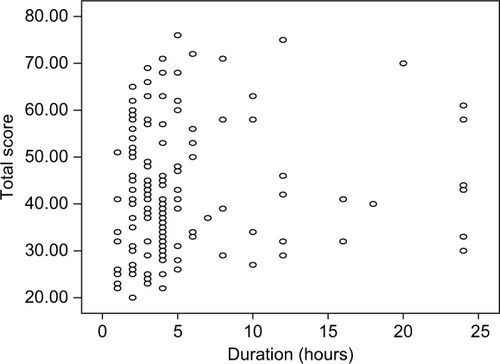
Figure 3 Association between examination grade (1=A, 2=B, 3=C, 4=pass) and duration of Internet usage in hours (N=147).
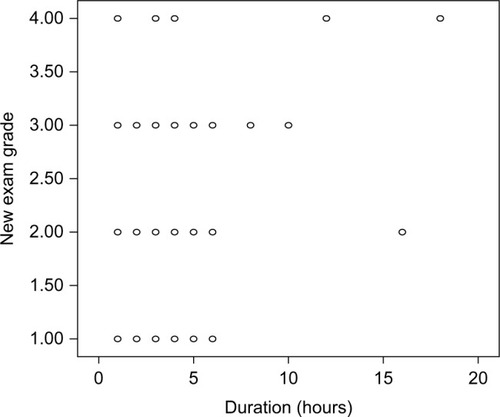
Table 3 Comparison of total scores of Internet addiction test between sociodemographic characteristics using independent t-test (N=149)
Table 4 Post hoc analysis of comparison of total scores of Internet addiction test between the years of study using Mann–Whitney U test (N=149)
Table 5 Correlation between total scores of Internet addiction test and exam grade, age (in years), and duration of daily Internet usage (in hours) using Pearson’s correlation test (N=149)
Table 6 Correlation between examination grade and duration of Internet usage (N=147) found using Spearman’s correlation test
Majority of the participants possessed two gadgets for browsing the Internet (64.4%), had one Internet connection (65.8%), got an account on Facebook (86%), and used WhatsApp for texting (74.5%). The number of social network accounts of the SPs was 0–1 (71.14% [106]) or 2–3 (18.79% [28]). Unfortunately, none of these components showed any statistically significant difference (p>0.05) when compared using Kruskal–Wallis test and Mann–Whitney test (). Median and interquartile range are used here instead of mean and standard deviation (SD) because the variable is skewed and not normally distributed, and thus, using mean and SD will give a biased average. All participants had email addresses and the specifics are portrayed in . It was noted that 87% and 13% of students had one and two email addresses, respectively (), but they did not indicate their most commonly used email addresses. The reasons for Internet use included (): social networking (56.2%), entertainment (39.7%), educational (34.9%), research (12.3%), and email communication (12.3%). Approximately half and one-third of the participants were suffering from mild and moderate addiction, respectively, and the subsequent problems resulting from Internet usage (). It was noted that one-quarter of the students had no IA.
Table 7 Comparison of total scores of Internet addiction test between social media characteristics using nonparametric test (N=149)
Discussion
IA has become a progressively more dominant public health issue for out-and-out research concerns from abundant scientific arenas including psychology, psychiatry, and neuroscience.Citation45 In the present study, the response rate of the participants was 80.11%, which is very similar to that of a Danish study.Citation46 Moreover, female medical students were outnumbered by their male counterparts, which was demonstrated in many studies from other countries.Citation47–Citation55 Average age of the students of this study was also similar to other Malaysian studies conducted in medical schools.Citation47–Citation52,Citation56 Many studies also supported the findings of the present study that the majority of the students spent online than they intended.Citation9,Citation57 The students occasionally neglected their household responsibilities, which was in line with the findings of other studies.Citation9,Citation58,Citation59 The preference of excitement of the Internet over intimacy with the partner was also revealed in studies conducted in separate contexts using different instruments.Citation59–Citation62 US college students also form new relationships with fellow online users, as found in the present study.Citation63 About one-fifth of the students reported that they received frequent complaints about spending much time online. However, another study from the USA reported only 1%, which is much lower than that in the present study.Citation63 More than half (>50%) of the respondents stated that their academic performance was affected either frequently or occasionally; however, a number studies recorded lower response (<50%).Citation63,Citation64 In this study, just over 50% of students either frequently or occasionally declared that they checked email first before doing any other work, but it was much lower in the US study (37%) and in an Italian study (23%).Citation63,Citation64 It was also found that over 50% students either frequently or occasionally declared that their job performance was affected because of Internet use, but it was much lower in studies of the modern world (26%–41%).Citation63,Citation64 A group of scientists claimed that behavioral addictions, such as substance addictions, bring to mind numerous areas, which include natural history, phenomenology, tolerance, comorbidity, overlapping genetic contribution, neurobiological mechanisms, and response to treatment, supporting the DSM-V Task Force proposed new category of Addiction and Related Disorders encompassing both substance use disorders and nonsubstance addiction.Citation65 Majority (>50%) of the students showed defensive behavior when they were asked about Internet usage. This figure was much higher than that reported in the study conducted in the USA.Citation65 Nonetheless, defensive behavior is often seen in substance addiction and is called as “Freudian defense mechanism”.Citation66 Obsessive intrusive thoughts are defined as unwelcome, involuntary thoughts, images, or unpleasant ideas that may become obsessions, are upsetting or distressing, and can be difficult to be free of and manage.Citation67 About 65% of the current SPs suffered, more or less, from disturbing thoughts in their life. The current findings were much higher earlier studies in Europe and North America.Citation63,Citation64 Therefore, some of the SPs were facing some obsessive behavior. More than 68% of the SPs anticipated that they would go online again. This result was again much higher than that reported in an earlier study,Citation61 but almost similar to that reported in another study.Citation64 Anticipating subsequent online sitting is a diagnostic feature of IAs.Citation68 About 70% of the respondents considered that their life would be boring, empty, and miserable without the Internet. Again, this figure is much higher than that reported in a previous study,Citation63 but practically similar to the result of another study.Citation64 This finding was in the same line with the findings of a number of research reports on people who think that life devoid of the Internet or substance abuse will be troublesome.Citation62,Citation69,Citation70 Less than half (<50%) of SPs get irritated and shout with others for bothering them while browsing the Internet. Studies of the modern world reported much lower figure than the current study.Citation63,Citation64 Multiple studies have described substance addicts’ behavior, including the signs and symptoms. The ones that are regularly noticed include obsession, engaging in the behavior even though it is causing harm, compulsively engaging, withdrawal, loss of control, denying problems, hiding the behavior, blackout, depression, poor self-esteem, feeling anxious, suicidal ideation, having no control over their environment, and coming from psychologically or physically abusive families.Citation71,Citation72 Therefore, the current SPs’ quarreling tendency is also in the same line of addiction. Just over >61% of SPs lose their sleep due to extended usage of the Internet. A number of studies reported that constant access to the Internet causes sleep disorders, depression, followed by low quality of work.Citation73,Citation74 Again, the finding on loss of sleep in the current study was much higher than that reported in previous studies.Citation63,Citation64 Among the current SPs, just over >50% of the population fantasizes when the Internet is offline and that soon they will be online. The substance users also showed similar feeling of daydreaming and sensed pleasure that actually persuaded and coerced them to repeat the behavior again.Citation75,Citation76 Yet again, the number of current SPs’ fantasizing was much higher than that reported in two earlier studies.Citation63,Citation64 Roughly 73% of the current SPs found themselves saying “just a few more minutes” when online; this figure was also much higher than that reported in earlier studies.Citation63,Citation64 Around 74% of the SPs tried to cut down the amount of time spent on Internet, but failed. These data were quite similar to that reported in the North American study, but much higher than that of the European study.Citation63,Citation64 More or less 58% of the SPs hide how long they are online. This finding is also much higher than that reported in earlier studies.Citation63,Citation64 A functioning addict can be defined as someone who is able to hide the excesses of their alcohol or drug use and develops a high degree of skill for hiding the addiction.Citation77,Citation78 Thus, at least a portion of the SPs may be suffering from addiction liability. Just over >50% of the SPs prefer spending more time online over going out with others; this figure is higher than that reported in the US study,Citation63 but quite similar to that of the Italian study.Citation64 A substance abuser or addict often prefers to mingle only with other addicts rather than with family members, relatives, and friends; the person also avoids family get-togethers or such events.Citation79 Hence, the current findings were also in the same line as the earlier report.Citation79 Around 44% of the SPs sometimes feel depressed, moody, or nervous while being offline, which goes away once they are back online; last but not least, this figure is also much higher than in the two earlier studies.Citation63,Citation64
There were no statistically significant (p=0.143) differences between genders. Similar insignificant differences were observed between genders in a study conducted at the Mahatma Gandhi Memorial Medical College, Indore, India.Citation80 The mean scores of both genders were between 31 and 49; therefore, both male and female medical students of UniSZA were suffering from mild IA, but had control of the usage. Among the current SPs, 49% suffered from mild addiction; various studies from different Asian countries reported 35%, 51.3%, and 57.77% to be suffering from mild IA.Citation28,Citation81,Citation82 Therefore, the current study data were quite similar to those of earlier studies.Citation28,Citation81,Citation82 A study conducted among medical students of the Middle East reported that 19.1% of them suffers from a moderate degree of IA, but the figure in the present study was little higher (32%).Citation83 Some Asian studies have reported that 0.3% and 0.9% were suffering from severe IA; nevertheless, in the present study, we were not able to detect any single medical student with severe IA,Citation28,Citation83 although a little positive, but not statistically significant (p=0.548) correlation was found between the examination grade and duration of Internet usage. Nonetheless, another recent Malaysian study reported that a significant (p=0.003) relationship was observed between cumulative grade point average and Internet usage during weekdays. However, there was no significant relationship between Internet usage and cumulative grade point average during weekends (p=0.677).Citation17 Another investigation conducted among Malaysian university students found statistically significant differences in academic performance between average users and excessive users (t=−18.95, degrees of freedom = 651, p<0.001).Citation84 Similar significant relationships were also observed in South Africa, but no relation of causality could be recognized between rigorous Internet usage and poor academic performance, even though the study results approved the negative effects on academic achievement due to abusive use of the Internet.Citation85 Another Indian survey conducted on 500 medical students of three reputed medical institutes (Hamdard Institute of Medical Sciences and Research, New Delhi; All India Institute of Medical Sciences, Jodhpur; and Dr SN Medical College, Jodhpur) revealed that there is a significant relationship between students’ usage of the Internet and their academic performance.Citation86 Another appraisal conducted among 400 South Asian science and technology university students found that IA had a statistically significant negative relationship with academic performance (r=−0.13, p<0.0).Citation87 Consequently, the current study findings were in the same line as those of earlier studies of home and neighboring countries.
Limitations of the study
The study has a number of limitations. This cross-sectional study involved only students of a medical school in Malaysia and had a small sample size; therefore, caution needs to be taken to generalize the findings. Moreover, as the study was cross-sectional, it was not possible to conclude a cause–effect relationship between the causative factors and IA among students. Longitudinal, multicentered studies with large sample size should be conducted to identify the trends of Internet usage among health care professional students and its likely implications on students’ learning and their physical and mental health.
Conclusion
The present study revealed that 81% (49%+32%) of the SPs had mild to moderate IA, according to the study instrument of Dr Kimberly S Young. The study as well concludes that both male and female medical students were suffering from mild IA. It was found that the majority of participants frequently stayed online longer than they intended. Approximately 13% was always online longer than they had planned. Majority of the participants mentioned that Internet usage occasionally made them neglect their household chores and hampered their academic performance or productivity. IA is becoming more prevalent among medical students. They are among high-risk PIU groups because they use the Internet for both educational purposes and noneducational purposes. Easy access to the Internet without parental control is one of the important factors for IA among medical students. This study finding is quite alarming and demands the attention of concerned educational authorities because this is a public university and medical education is heavily sponsored by the Government of Malaysia, with almost no out-of-pocket personal and parental expenses. A good amount of studentship allowance is provided for each and every medical student for day-today incidentals, which actually comes from the tax money paid by the Malaysian people. Appropriate preventive and interventional strategies need to be developed to encourage rational use of Internet in order to protect the physical and mental health of the users.
Acknowledgments
The authors are grateful to those medical students of Universiti Sultan Zainal Abidin (UniSZA) who participated in the current study. The authors are also obliged to Dr Kimberly S Young, an internationally known expert on Internet addiction, from the Center for Internet Addiction, for providing permission to use her questionnaire for this study. The authors also extend their heartfelt thanks to all members of the UniSZA Research Ethics Committee, especially to the Chairman of the ethical committee, Prof Dato’ Dr Ahmad Zubaidi Bin Abdul Latif, MD, MMED, FRCS, for his very kind cooperation. Dato’ Dr Latif currently holds the position of Vice-Chancellor of the UniSZA, Malaysia.
The authors obtained no funding for this study. The principal author bore all the cost where necessary because of his personal interest in this particular area.
Disclosure
The authors report no conflicts of interest in this work.
References
- MuniandyBAcademic use of internet among undergraduate students: a preliminary case study in a Malaysian UniversityInt J Cyber Society Educ201032171178
- TeongKVAngMCInternet use and addiction among students in Malaysian public Universities in East Malaysia: some empirical evidenceJ Manage Res2016823147
- MajumderMAAAzimMSSRahmanSTechnology-enhanced learning in Asia: New educational possibilities for the tomorrow’s doctors and tomorrow’s curesSouth East Asia J Public Health2013425053
- AyubAFMHamidWHWNawawiM HjUse of internet for academic purposes among students in Malaysian institutions of higher educationTurk Online J Educ Tech2014131232241
- LuXYeoKJPathological internet use among Malaysia University students: risk factors and the role of cognitive distortionComput Human Behav201545235242
- LiLHongliLDefinition and measurement on pathological internet useJ Dev Psychol20031117377
- XiLJiarYKDepression and internet use in a sample of Malaysian Undergraduate studentsJ Educ Vocat Res2013411317325
- NiemzKGriffithsMBanyardPPrevalence of pathological Internet use among university students and correlations with self-esteem, the General Health Questionnaire (GHQ), and disinhibitionCyberpsychol Behav20058656257016332167
- AboujaoudeEProblematic Internet use: an overviewWorld Psychiatry201092859020671890
- NayakRDInternet addiction a comparative study between undergraduate students of India and MalaysiaInt J Indian Psychol201524116120
- SaiedSMElsabaghHMEl-AfandyAMInternet and Facebook addiction among Egyptian and Malaysian medical students: a comparative study, Tanta University, EgyptInt J Community Med Public Health20163512881297
- TusharBSwapnaliKPoojaBComputer and internet use among undergraduate medical studentsInt J Contemporary Med Res20163513711321
- Al-DubaiSAGanasegeranKAl-ShaggaMAYadavHArokiasamyJTAdverse health effects and unhealthy behaviors among medical students using FacebookScientific World J20132013465161
- AjuwonGAComputer and internet use by first year clinical and nursing students in a Nigerian teaching hospitalBMC Med Inform Decis Mak200331014498997
- KumarSTadakamadlaJTibdewalHDuraiswamyPKulkarniSInternet usage among undergraduate dental students in IndiaRev Odonto Ciênc2010253261265
- GhabiliKAlizadehMComputer and Internet use among Iranian medical studentsMed Educ200842111418181851
- SirajHHSalamAHasanNABJinTHRoslanRBOthmanMNBInternet usage and academic performance: a study in a Malaysian public universityInt Med J20152228386
- HaqueATMESugathanSAliOIslamMZHaqueMUse of electronic devices by the medical students of UniKL-RCMP, Malaysia, and its influence on academic performancesNatl J Physiol Pharm Pharmacol2016613845
- CashHRaeCDSteelAHWinklerAInternet addiction: a brief summary of research and practiceCurr Psychiatry Rev20128429229823125561
- CaoHSunYWanYHaoJTaoFProblematic Internet use in Chinese adolescents and its relation to psychosomatic symptoms and life satisfactionBMC Public Health20111180221995654
- GriffithsMWoodRTRisk factors in adolescence: The case of gambling, videogame playing, and the internetJ Gambl Stud2000162–319922514634313
- YoungKSCaseCJInternet abuse in the workplace: new trends in risk managementCyberpsychol Behav20047110511115006175
- LiuTPotenzaMNProblematic internet use: clinical implicationsCNS Spectr20071264536617545956
- SalehiMKhaliliMNHojjatSKSalehiMDaneshAPrevalence of internet addiction and associated factors among medical students from Mashhad, Iran in 2013Iran Red Crescent Med J2014165e1725625031856
- BlockJJIssues for DSM-V: internet addictionAm J Psychiatry2008165330630718316427
- CollierRInternet addiction: New-age, diagnosis or symptom of age-old problem?CMAJ2009181957557619770257
- PiesRShould DSM-V Designate “Internet addiction” a mental disorder?Psychiatry (Edgmont)200962313719724746
- SharmaASahuRKasarPKSharmaRInternet addiction among professional courses students: a study from Central IndiaInt J Med Sci Public Health20143910691073
- KandellJJInternet addiction on campus: The vulnerability of college studentsCyberpsychol Behav2009111117
- ShawMBlackDWInternet addiction: definition, assessment, epidemiology and clinical managementCNS Drugs200822535336518399706
- Internet Gaming Disorders [webpage on the Internet]. A New Phenomena2013 Available from: http://www.dsm5.org/Documents/Internet%20Gaming%20Disorder%20Fact%20Sheet.pdfAccessed July 5, 2015
- The Daily Telegraph [webpage on the Internet]Internet addiction is a ‘clinical disorder’ Available from: http://www.telegraph.co.uk/news/uknews/2152972/Internet-addiction-is-a-clinical-disorder.htmlAccessed July 10, 2016
- The Guardian [webpage on the Internet]Addiction to internet ‘is an illness’ Available from: https://www.theguardian.com/technology/2008/mar/23/news.internetAccessed July 10, 2016
- KimHExercise rehabilitation for smartphone addictionJ Exer Rehabil201396500505
- LeeHA new case of fatal pulmonary thromboembolism associated with prolonged sitting at computer in KoreaYonsei Med J200445234935115119012
- MokJYChoiSWKimDJLatent class analysis on internet and smartphone addiction in college studentsNeuropsychiatr Dis Treat20141081782824899806
- KussDJInternet gaming addiction: current perspectivesPsychol Res Behav Manag2013612513724255603
- YoungKS webpage on the InternetInternet addiction: symptoms, evaluation, and treatment. innovations in clinical practiceVande CreekLJacksonTInnovations in Clinical Practice: A Source Book (vol. 17; pp. 19–31)Sarasota FLProfessional Resource Press1999117 Available from: http://treatmentcenters.com/downloads/internet-addiction.pdfAccessed July 8, 2016
- YoungKSInternet addiction: The emergence of a new clinical disorderCyberpsychol Behav200913237244
- Net Addiction [webpage on the Internet]The Center for Internet Addiction. Internet Addiction Test (IAT) Available from: http://netaddiction.com/internet-addiction-test/Accessed July 5, 2015
- LaconiSRodgersRFChabrolHThe measurement of Internet addiction: A critical review of existing scales and their psychometric propertiesComput Human Behav201441190220
- Creative Research System [webpage on the Internet]Sample Size Calculator2012 Available from: http://www.surveysystem.com/sscalc.htmlAccessed April 14, 2016
- NunnallyJCPsychometric Theory2nd edNew York, NYMcGraw-Hill1978
- BarmanMPHazarikaJKalitaAReliability, and validity of Assamese version of EORTC QLQ-C30 questionnaire for studying the quality of life of cancer patients of AssamWorld Appl Sci J2012175672678
- PontesHMKussDJGriffithsMDClinical psychology of Internet addiction: a review of its conceptualization, prevalence, neuronal processes, and implications for treatmentNeurosci Neuroecon201541123
- KongsvedSMBasnovMHolm-ChristensenKHjollundNHResponse rate and completeness of questionnaires: a randomized study of Internet versus paper-and-pencil versionsJ Med Internet Res200793e2517942387
- RahmanNIAAzizAAZulkifliZPerceptions of students in different phases of medical education of the educational environment: Universiti Sultan Zainal AbidinAdv Med Educ Pract2015621122225848333
- IsmailSSalamAAlattraqchiAGEvaluation of doctors’ performance as facilitators in basic medical science lecture classes in a new Malaysian medical schoolAdv Med Edu Pract20156231237
- BhagatVHaqueMSimbakNBJaalamKStudy on personality dimension negative emotionality affecting the academic achievement among Malaysian medical students studying in Malaysia and OverseasAdv Med Edu Pract20167341346
- HaqueMZulkifliZHaqueSZProfessionalism perspectives among medical students of a novel medical graduate school in MalaysiaAdv Med Edu Pract20167407422
- IsmailSRahmanNIAMohamadNPreference of teaching and learning methods in a new medical school of MalaysiaJ Appl Pharm Sci201442048055
- HoqueRMostafaAHaqueMIntern doctors’ views on the current and future antibiotic resistance situation of Chattagram Maa O Shishu hospital medical college, BangladeshTher Clin Risk Manag2015111177118526316762
- HaqueMRahmanNIZulkifliZIsmailSAntibiotic prescribing and resistance: knowledge level of medical students of clinical years of university Sultan Zainal Abidin, MalaysiaTher Clin Risk Manag20161241342627042083
- BBC [webpage on the Internet]Women docs “weakening” medicine2004 Available from: http://news.bbc.co.uk/1/hi/health/3527184.stmAccessed July 23, 2016
- EvaEOIslamMZMosaddekASPrevalence of stress among medical students: a comparative study between public and private medical schools in BangladeshBMC Res Notes20158132726223786
- TackettSBakarHAShilkofskiNACoadyNRampalKWrightSProfiling medical school learning environments in Malaysia: a validation study of the Johns Hopkins learning environment scaleJ Educ Eval Health Prof2015123926165949
- LamSM webpage on the InternetImpacts of internet addiction on youths in Hong Kong [MS dissertation]Department of Information Technology, University of Hong Kong2002 Available from: http://hub.hku.hk/bitstream/10722/36923/1/FullText.pdf?accept=1Accessed July 23, 2016
- DemetrovicsZSzerediBRózsaSThe three-factor model of Internet addiction: the development of the Problematic Internet Use QuestionnaireBehav Res Methods200840256357418522068
- WidyantoLMcMurranMThe psychometric properties of the internet addiction testCyberpsychology Behav200474443450
- MatasAOrman’s internet addiction survey: a preliminary psychometric study in an Universitary Andalusian sampleUniversitas Psychologica201514311071116
- FrangosCCFrangosCCSotiropoulos I [webpage on the Internet]. A meta-analysis of the reliability of young’s internet addiction testProceedings of the World Congress on Engineering20121368371 Available from: http://www.iaeng.org/publication/WCE2012/WCE2012_pp368-371.pdfAccessed July 23, 2016
- KhazaalYAchabSBillieuxJThorensGZullinoDDufourMRothenSFactor structure of the internet addiction test in online gamers and poker playersJMIR Ment Health201522e1226543917
- ChristakisDAMorenoMMJelenchickLMyaingMTZhouCProblematic internet usage in US college students: a pilot studyBMC Med201197721696582
- CampanellaMMucciFBaroniSNardiLMarazzitiDPrevalence of internet addiction: a pilot study in a group of Italian high-school studentsClin Neuropsychiatry2015129093
- GrantJEPotenzaMNWeinsteinAGorelickDAIntroduction to behavioral addictionsAm J Drug Alcohol Abuse201036523324120560821
- 12 Keys REHAB [webpage on the Internet]The Relationship Between Drug Addiction, Lies and Bad Behavior2016 Available from: http://www.12keysrehab.com/blog/the-relationship-between-drug-addiction-lies-and-bad-behavior/Accessed July 27, 2016
- Sound-Mind Org [webpage on the Internet]Obsessive Thinking Ending Scary Thoughts Available from: http://www.sound-mind.org/obsessive-thinking.html#.V5hWYGh97IUAccessed July 27, 2016
- BeardKWInternet addiction: a review of current assessment techniques and potential assessment questionsCyberPsychology Behav200581714
- AboujaoudeEKoranLM webpage on the InternetImpulse control disordersCambridge University Press2010 Available from: http://correctingconduct.weebly.com/uploads/3/9/1/9/39199717/2010_-_impulse_control_disorders_-_aboujaoude__koran.pdfAccessed July 27, 2016
- LinnoilaMVirkkunenMGeorgeTHigleyDImpulse control disordersInt Clin Psychopharmacology199385356
- EngsRCCultural Use of Alcohol and Other Drugs, Alcohol and Other Drugs: Self-ResponsibilityBloomington ILTichenor Publishing Co2012
- National Centre for Education and Training on Addiction (NCETA) Consortium [webpage on the Internet]Alcohol and Other Drugs: A Handbook for Health ProfessionalsAustralian Government Department of Health and Ageing2004 Available from: https://www.health.gov.au/internet/main/publishing.nsf/Content/E5203E6D5CBAA696CA257BF0001E02ED/$File/aodgp.pdfAccessed July 27, 2016
- MacraeF webpage on the InternetConstant Internet access ‘causes sleep disorders and depression with late night users most likely to suffer’ Mail Online2012 Available from: http://www.dailymail.co.uk/sciencetech/article-2158035/Constant-Internet-access-causes-sleep-disorders-depression-late-night-users-likely-suffer.htmlAccessed July 28, 2016
- LackDMPresenteeism revisited. A complete reviewAAOHN J2011592778921323209
- National Institute of Drug Abuse [webpage on the Internet]Advancing Addiction Science. Drugs, Brains, and Behavior: The Science of Addiction2014 Available from: https://www.drugabuse.gov/publications/drugs-brains-behavior-science-addiction/drugs-brainAccessed July 28, 2016
- Center for Substance Abuse Treatment [webpage on the Internet]Treatment for Stimulant Use DisordersRockville MDSubstance Abuse and Mental Health Services Administration (US)1999[Treatment Improvement Protocol (TIP) Series, No. 33.] Chapter 2—How Stimulants Affect the Brain and Behavior Available from: http://www.ncbi.nlm.nih.gov/books/NBK64328/Accessed July 28, 2016
- Alcoholrehab.com [webpage on the Internet]Recognize a Functioning. Addict Not All Addicts Fit the Stereotype Available from: http://alcoholrehab.com/drug-addiction/recognize-a-functioning-addict/Accessed July 28, 2016
- Alcoholrehab.com [webpage on the Internet]Hiding an Addiction Available from: http://alcoholrehab.com/addiction-articles/hiding-an-addiction/Accessed July 28, 2016
- Center for Substance Abuse Treatment [webpage on the Internet]Substance Abuse Treatment and Family TherapyRockville MDSubstance Abuse and Mental Health Services Administration (US)2004[Treatment Improvement Protocol (TIP) Series, No. 39.] Chapter 2 Impact of Substance Abuse on Families Available from: http://www.ncbi.nlm.nih.gov/books/NBK64258/Accessed July 28, 2016
- MalviyaADixitSShuklaHMishraAJainATripathiAA Study to evaluate Internet addiction disorder among students of a medical college and associated hospital of central IndiaNatl J Community Med2014519395
- NaffiseMMohammadAAhmadPBThe prevalence of Internet addiction among the students of Rafsanjan University of Medical SciencesASEAN J Psychiatry2013142109116
- ChathothVKodavanjiBArunkumarNPaiSRInternet behavior pattern in undergraduate medical students in MangaloreInt J Innovative Res Sci Eng Tech20132621332136
- MazaheriMANajarkolaeiFRCell phone and internet addiction among students in Isfahan University of medical sciences-IranJ Health Policy Sustainable Health201413101105
- ZainudinADinMMOthmanMImpacts due to internet addiction among Malaysian university studentsInt J Asian Soc Sci20133919221928
- Ngoumandjoka UT [webpage on the Internet]Correlation between Internet usage and academic performance among university students (Masters’ dissertation)Johannesburg SFFaculty of Science, University of the Witwatersrand2012 Available from: https://core.ac.uk/download/files/979/39671756.pdfAccessed July 30, 2016
- SinghBGuptaRGargRStudy of Medical Students and Internet UsageInt J Sci Res Publications20133515
- AkhterNRelationship between internet addiction and academic performance among university undergraduatesEduc Res Rev201381917931796

